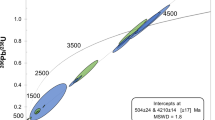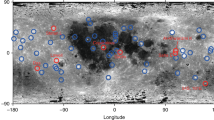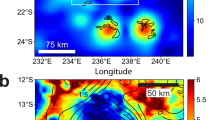Abstract
RECENTLY, Gold1 has discussed the origin of the lunar craters and maria. He concurs in the meteorite impact theory of the origin of the craters advocated by Baldwin2, and agrees in major conclusions on the impact of explosions with Gilvarry and Hill3. For strong reasons4, Gold argues against lava as the agent producing the smooth dark surfaces of the maria (which he presumes to arise in the first instance merely as meteoritic craters considerably larger than the average). He proposes to explain the smooth surfaces by an erosion process creating dust in the highlands, coupled with a transport mechanism depositing it in the maria. The purpose of this communication is to point out the possibility of explaining simultaneously the erosion and transport required in Gold's theory, by a process known to be operative on the Earth on a large scale (in contrast to some suggestions by Gold and by Urey4).
This is a preview of subscription content, access via your institution
Access options
Subscribe to this journal
Receive 51 print issues and online access
$199.00 per year
only $3.90 per issue
Buy this article
- Purchase on Springer Link
- Instant access to full article PDF
Prices may be subject to local taxes which are calculated during checkout
Similar content being viewed by others
References
Gold, T., Mon. Not. Roy. Astro. Soc., 115, 585 (1955).
Baldwin, R. B., “The Face of the Moon”, 42, 114–153, 191 (University of Chicago Press, Chicago, 1949).
Gilvarry, J. J., and Hill, J. E., Pub. Astro. Soc. Pacific, 68, 223 (1956); Astrophys. J., 124, 610 (1956).
Urey, H. C., Angew. Chem., 68, 533 (1956).
Gutenberg, B., in Gutenberg, B. (ed.), “Internal Constitution of the Earth”, 319–335 (2nd ed., Dover Pub. Inc., New York, 1951).
Gutenberg, B., and Richter, C. F., “Seismicity of the Earth”, 18 (Princeton Univ. Press, 1949).
Heiland, C. A., “Geophysical Exploration”, 143 (Prentice-Hall, Inc., New York, 1940).
Bullen, K. E., “Introduction to the Theory of Seismology”, 237 (Camb. Univ. Press, 1953).
Morrison, P. (referred to by Gold, ref. 1).
Heck, N. H., “Earthquakes”, 208 (Princeton Univ. Press, 1936).
Davison, C., “Great Earthquakes”, 112 (Murby, London, 1936).
Author information
Authors and Affiliations
Rights and permissions
About this article
Cite this article
GILVARRY, J. Nature of the Lunar Surface. Nature 180, 911–912 (1957). https://doi.org/10.1038/180911a0
Issue Date:
DOI: https://doi.org/10.1038/180911a0
This article is cited by
-
The Origin of Ocean Basins and Continents
Nature (1961)
-
Origin and Nature of Lunar Surface Features
Nature (1960)
Comments
By submitting a comment you agree to abide by our Terms and Community Guidelines. If you find something abusive or that does not comply with our terms or guidelines please flag it as inappropriate.



